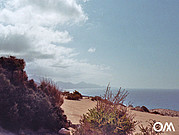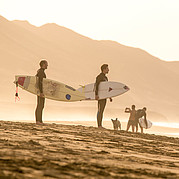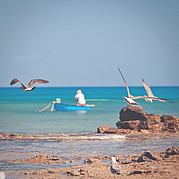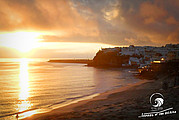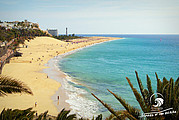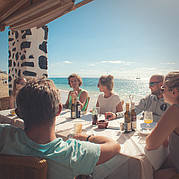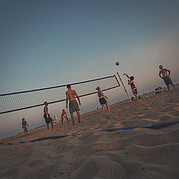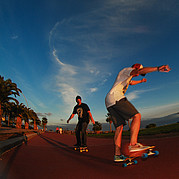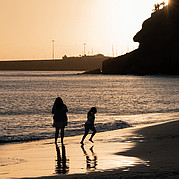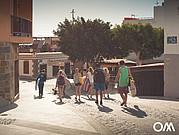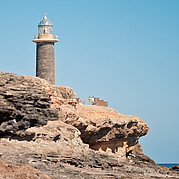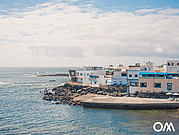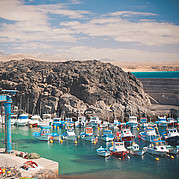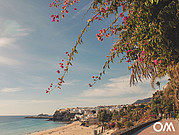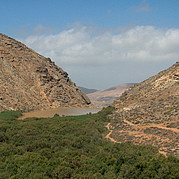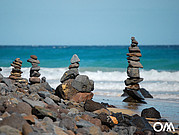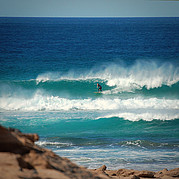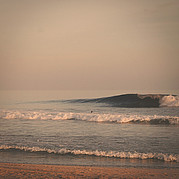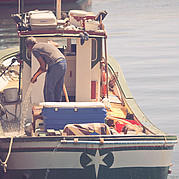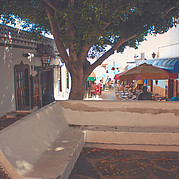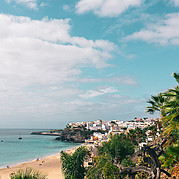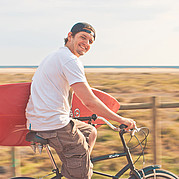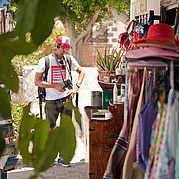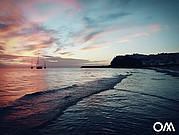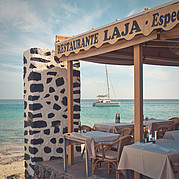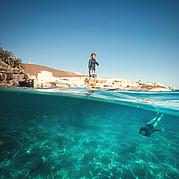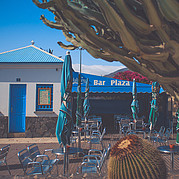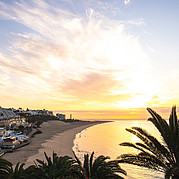Reef surfing in the south of Fuerteventura
Fuerteventura is considered the Hawaii of Europe. The comparison is of course due to the summer temperatures all year round. Even in winter, there are surf days here when you can surf in board shorts or bikini. The Canary Islands also share volcanic origins with the Hawaiian archipelago. The relaxed lifestyle of the locals is another thing they have in common. Here on Fuerteventura, you often get the feeling that the clocks literally tick slower. The main reason for the metaphor of the European Hawaii, however, is of course the many good waves that break on very different coasts of Fuerteventura.
Just like the famous north coast of the Hawaiian island of Ohau, Fuerteventura is also known for its many waves on the north shore. These all break on reefs and are therefore very constant.
There are also reefs for surfing in the south of Fuerteventura. The waves here break just as consistently and cleanly as on comparable reefs on the north coast.
Directions to the southwest of Fuerteventura
The route to the reefs in the south of Fuerteventura starts in Morro Jable. Morro Jable is the last large town in the south of the island. It is signposted on the motorway from the airport. So if you don't live directly in Morro Jable, take the motorway south to Morro Jable.
At the end, the motorway leads to a roundabout and the road behind it becomes single-lane. It descends in serpentines to the beach of Jandia. After another roundabout, the road becomes two lanes again and the beach promenade of Jandia begins, surrounded by palm trees. You just follow this road to its end. Now the road leads over a hill that separates Jandia from Morro Jable. You continue to follow the road until you reach another large roundabout in the direction of the port (Spanish: Muelle).
The road continues above the village for a while and then goes downhill again towards the harbour. Shortly before the harbour, opposite many small colourful terraced houses, there is a turn-off to the right. A sign tells you that this is the way to the cemetery (Spanish: cementerio). Turn right here in the direction of the cemetery. After a few more hairpin bends above the harbour of Morro Jable, you will reach the cemetery. This is where the long, unpaved gravel road begins, which also leads to Cofete.
Caution:
Most car rental companies are not liable for damages if the cars are driven on gravel roads. Towing services for flat tyres can quickly become quite expensive. Those who drive this track with a "normal" car should therefore be especially careful. Although the track is renewed at least once a year, there are many passages with large holes and bumps. Ideally, you should rent an off-road vehicle with four-wheel drive. Most car rental companies also offer simple four-wheel drive vehicles.
The gravel road now winds for about 16 kilometres past the majestic mountains of the southwestern tip of Fuerteventura. At the halfway point, you will pass an old tomato farm. When you pass the next mountain flank, the view of the waves in the south of the island opens up for the first time. From here, you can easily see the whitecaps of the waves on the reefs in the south of Fuerteventura.
The waves on the reefs in the south of Fuerteventura
Depending on the wind and waveconditions, good waves break on different reefs in the south of Fuerteventura. It doesn't necessarily have to be the same conditions that cause waves on the reefs on the well-known north coast of Fuerteventura. There are a lot of variables that determine how and where waves break on the reefs in the south. Not only is the size of the waves important, but also the force. The force of the waves is also called the period and is measured in seconds. Of course, the direction from which the waves come also plays a role.
The tide also plays a big role. On some reefs, the waves run at all tide levels. On most reefs, as the tide changes, the waves change their shape, the way they break and the start from where they break. There are also some reefs in the south of Fuerteventura that are only surfable at certain tides.
I myself have lived in the south of Fuerteventura for several years and I go surfing regularly on the reefs in the south of the island. Even after more than 10 years, there are still many days when I gather new experiences. Year after year, I learn more about which surf conditions are optimal on which reef.
What to look out for when surfing the reefs in the south of Fuerteventura
The reefs in the south of the island are only for surfers who are really advanced and experienced. Paddling and getting green waves safely is essential. If you have some surfing experience, you will find your personal perfect wave on the reefs in Fuerteventura's south on the right day. However, you should be able to judge your surfing level well. On most reefs there are certain points where surfers go into the water and come back out of the water to land. If you are not sure where these points are, watch other surfers. This way you avoid putting yourself in danger unnecessarily by overlooking certain rocks or currents.
It is not uncommon to enter and exit the water over sharp-edged lava. If you don't have a bit of callus on your feet and aren't sure-footed, it's better to wear surf booties here. You can't ride almost all the waves all the way into the white water. Some of the waves break at the end in very shallow water, directly onto the sharp-edged reef. You should therefore recognise the point where you have to get out of the wave at the latest.
It can happen on Fuerteventura's southern reefs that you share good waves with only a few other surfers. This is something special and not taken for granted in Europe nowadays. Many surfers grew up here in the south of Fuerteventura and surf their reefs for half their lives. The local surfers know about the treasure on their doorstep and protect it wherever possible. You should therefore be as respectful as possible in all matters. Put yourself in the position of the locals: Imagine your personal favourite place in nature at home. Analyse your feelings when you imagine that this place is visited by people who behave disrespectfully towards people and nature. Would you welcome these people with open arms? Probably not.
So you shouldn't expect the island's local surfers to burst into cries of joy when they see rental cars with four surfboards on the roof in front of a reef in the south of the island. As a little "surfing etiquette", I would highly recommend that you don't go to the reefs with more than one other surfer. Friendly greetings to all present are obligatory, with "zero expectation" of a corresponding gesture from the other person. Even if you, as an experienced surfer, should be able to recognise where the peak of the wave is, you should not go directly to this place in the water. Instead, slowly work your way there and wait your turn.
A little sustainable diplomacy can make surfing together much more relaxed. It can also make sure that your wave yield increases day by day in the days to come.
Conclusion about surfing on the reefs in the south of Fuerteventura
There is a reason that this article is in many places generally written and explicitly points out the dangers of the sharp-edged bottom, as well as calling for defensivelyfriendly behaviour towards local surfers.
The waves on the reefs in the south of Fuerteventura can indeed get quite good. However, even under torture, I would not reveal what wave and wind conditions are necessary for that. Because there is one problem with Fuerteventura's southern reefs: Most of those waves only tolerate very few surfers. The fact that there are still days when only a handful of surfers share the line ups in Fuerteventura's south is something very special. It's actually what every surfer dreams of at night: sharing good waves only with the best friends. If you've already discovered such a place yourself, you'll understand what I'm writing about.
Don't think of surfing Fuerteventura's southern reefs as a day trip. It's a mission. It takes time to get to know each surf spot. It takes time to find your personal perfect wave. Those who invest this time will soon realise what a treasure they have found. And then, just like a treasure hunter, he or she will answer with a cheeky smile when asked for the right way.
Aloha.


